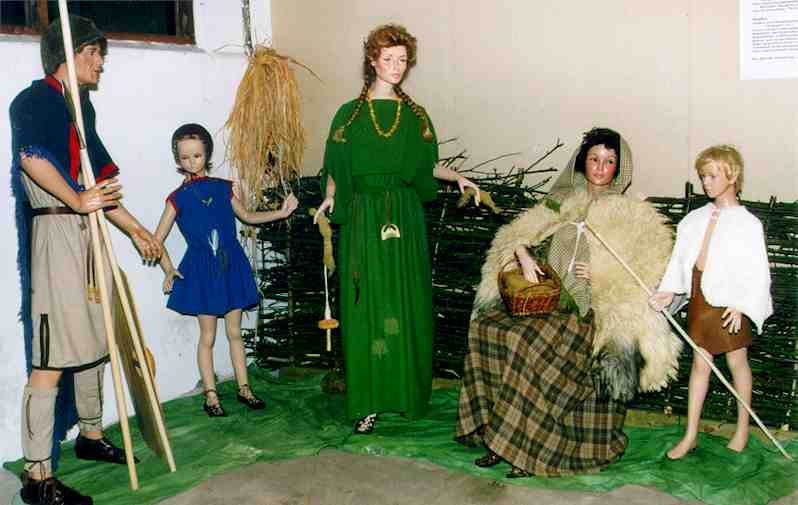Click the figures on the picture (3 ) (33 kb)
The Standing Woman
Dress (peblos) from Huldremosen, Djursland, Denmark. Celtic / Roman Iron Age. (Munksgård, p. 144).
Belt with fringes. A relief on a tombstone. The museum of Klagenfurt, Germany. (Hald, p. 377).
Knife from Hjemsted, Skærbæk, Denmark.
Comb, made of horn, placed in a pocket of a sheepskin cape from Huldremosen, Djursland, Denmark. Early Celtic Iron Age. (Hald, p. 187).
Ribbon in a plait of a woman in Haraldskær bog, Vejle, Denmark. 450 BC (Ebbesen, p. 7).
The spindle is from the Hjortspring Find, 350 BC. Celtic Iron Age (Rosenberg, p. 67).The Sitting Woman
Sheepskin cape from Huldremosen, Djursland, Denmark. Celtic Iron Age. (Munksgård, p. 136).
Leather coil on skin cape. Celtic Iron Age. (Hald, p. 324).
Scarf with fringes and a bird’s claw from Huldremosen, Djursland, Denmark. Celtic Iron Age. (Hald, p. 44 and 45).
Check patterned skirt from Huldremosen, Djursland, Denmark. Celtic Iron Age. (Munksgård, p. 139).
The Girl
Bonnet from Bredmose in Store Arden, Denmark. Celtic Iron Age. (Hald, p. 25).
Blouse with bronze brooches and woven trimming as the Lønnehede girl. Denmark. Early Roman Iron Age, 100A. D. (Munksgård, p. 142).
Miniskirt from Damendorf Ruchmoor, Schleswig. Germany. Celtic Iron Age. (Munksgård, p. 141).The Boy
Cape, white calfskin (instead of reindeer skin), closed by means of leather straps and buttons. From Damendorf Ruchmoor, Schleswig, Germany. Celtic Iron Age. (Munksgård, p. 127).
Peasant’s coat, made of cow’s skin, with leather ribbons. From Søgård bog, Daubjerg, Denmark. Not dated. Reminds of Bronze Age.
Spear, the Hjortspring Find, Celtic Iron Age. 350 B. C. (Rosenberg, p. 45).The Man
Fur hat with leather ribbons and buttons, from Tollund bog, Jutland, Denmark. Celtic Iron Age. (Munksgård, p. 191).
Sleeveless coat from Obenaltendorf, Schleswig, Germany. Celtic Iron Age. (Hald, p. 345).
Girdle buckle, and hanging bronze ornament. Found in northern Als, Denmark. Not dated, (orig.).
Fittings on end straps of the belt. The Hjortspring Find. 350 BC (Rosenberg, p. 61).
Swaddling clothes for the legs, from Søgård bog, Skive, Denmark. Celtic Iron Age. (Hald, p. 30).
Mantle. Many findings of woollen square rugs from Celtic Iron Age. (Munksgård, p. 65).
Pin, from the Hjortspring Find, 350 BC. Celtic Iron Age (Rosenberg, p. 61).
Lance, spear and shield, the Hjortspring Find, 350 BC. Celtic Iron Age. (Rosenberg, p. 43 - 64).
Shoes in general
Arnitlund bog and Rønbjerg bog. Celtic Iron Age. (Hald, p. 335 / 336).
Remarks
In the Iron Age the sheep had not only brown wool, but fair wool as well. It was possible to dye this by means of vegetable colours. By weaving, textiles were produced with an increasing number of threads per cm, over the centuries. Some were fulled, (washed in urine), which resulted in shrinking. Then it might have been scraped. Two ways of making the textile more warm and soft. Check patterned textiles and the fashion with blouse and skirt were typical Northern European. Woven ribbons were used in different ways. How to produce them is shown in Boye’s book. The production of the girl’s bonnet (a net) is well described in Bonnier’s dictionary, and in Hald’s book, page 25 and 254.
The textiles of the display are made by power loom, and dyed in a modern way. The clothing is handmade with stitches as used in Celtic Iron Age. (Hald, p. 284).
Sponsors
Fa. Sandbeck, Nordborg.
Tøjeksperten - Herremagasinet, Nordborg.
Kvickly, Nordborg.
Djon’s møbelpolstring, Nordborg.
Dorit Hansen, Stenløse.
Eigil Ebsen, Femina Hårstudie, Vojens.
Hjortspring Boat Utensils (Shields Spears Swords Tools People) Guild Events Feedback Links
